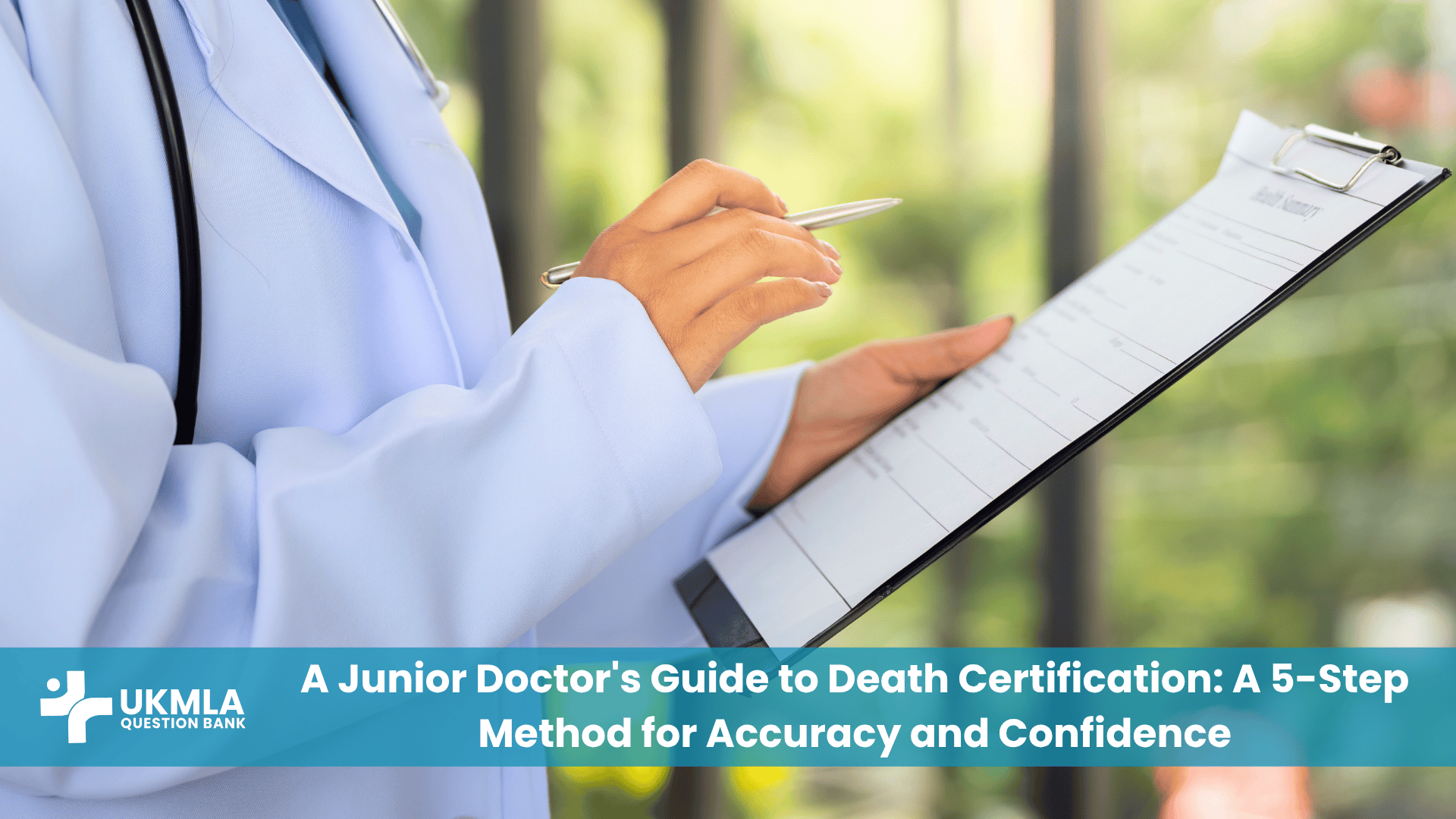Introduction
Learning how to write a death certificate UK junior doctors will find is one of the most significant responsibilities they assume upon qualification. This solemn duty is far more than an administrative task; it is a legal document, a vital piece of national health data, and the final summary of a patient’s life for their bereaved family. The weight of this responsibility, coupled with the complexities of formulating a cause of death and knowing when to involve the Coroner, can cause significant anxiety for new doctors.
This guide provides a clear, practical, and systematic 5-step framework to navigate the process with accuracy and confidence. From the initial verification to communicating with relatives, we will break down each component, providing actionable advice, templates, and checklists. Mastering this process is a core competency, essential for your foundation years and a key part of your professional identity as you take the next steps after qualifying as a UK graduate.
Table of Contents
ToggleKey Takeaways
It’s a Legal Document: Treat the Medical Certificate of Cause of Death (MCCD) with the utmost seriousness. Accuracy is not just good practice; it’s a legal requirement.
Master the Cause of Death Sequence: Understand the crucial difference between Part I (the direct causal chain) and Part II (contributory factors) to create a logical and accurate statement.
“When in Doubt, Refer”: The threshold for referring a death to the Coroner is low. Familiarize yourself with the referral criteria and never hesitate to discuss a case if you are unsure.
Communication is Key: Your role extends beyond the form. Communicating clearly and compassionately with the bereaved family is a fundamental part of the process.
Why Death Certification is a Core Professional Responsibility
Strengthening the “Why”: Legal, Statistical, and Familial Importance
Completing an MCCD is not just “paperwork.” It serves three critical functions that the UKMLA and your supervisors will expect you to understand. Understanding how to write a death certificate UK-style is a key part of this professional responsibility.
Legal Function: The MCCD is the legal prerequisite for the registration of a death, allowing the family to arrange a funeral and settle the deceased’s affairs. An inaccurate or incomplete certificate can cause significant delays and distress for the family.
Public Health Function: The information on death certificates is collected by the Office for National Statistics (ONS). This data is vital for monitoring public health trends, tracking disease prevalence, and informing national health policy and research.
Familial Function: For the bereaved, the death certificate is often the final, official document summarizing their loved one’s illness. A clear, logical, and accurate cause of death can provide a sense of closure and understanding.
Your role in this process is governed by strict professional standards, as it sits at the intersection of clinical practice, communication, and the law. A solid understanding of the principles in our guide on UKMLA Medical Ethics and Law is essential.
The 5-Step Method for Writing a Death Certificate in the UK
Follow this systematic process every time to ensure accuracy and safety.
Step 1: Verify Patient Identity and Confirm Death
Verify Identity: Check the patient’s wristband, hospital notes, and any other identifiers.
Confirm You Are the Right Doctor: You must be a registered medical practitioner who attended the deceased during their last illness.
Review the Notes: Thoroughly review the patient’s medical records, including the circumstances leading up to their death.
Step 2: Formulate the Cause of Death (Part I and Part II)
This is the most challenging part. You must create a logical sequence of events. The MCCD is split into two parts.
“Formulating the cause of death is a narrative skill. You are telling the final clinical story in a structured, logical sequence. Part I is the plot, and Part II is the important subplot.” — Medical Examiner
Part I: The Causal Sequence
Ia: The immediate cause of death (e.g., Pneumonia).
Ib: The condition that led to Ia (e.g., Metastatic Lung Cancer).
Ic: The underlying cause that led to Ib (e.g., Adenocarcinoma of the Lung).
Think: “Ia happened due to Ib, which happened due to Ic.”
Part II: Significant Contributing Factors
This is for other significant conditions that contributed to the death but were not part of the direct causal sequence.
Example: A patient dies from a Myocardial Infarction (Part I), but also has Type 2 Diabetes and COPD (Part II).
Step 3: Determine if a Referral to the Coroner is Required
You have a legal duty to refer a death to the Coroner in certain circumstances. The threshold is low.
Table 1: Checklist for Coroner’s Referral
| Referral Criteria | Question to Ask Yourself |
|---|---|
| Unknown Cause of Death | Am I unable to formulate a cause of death to the best of my knowledge and belief? |
| Violent or Unnatural Death | Was the death due to an accident (including falls), suicide, assault, or misadventure? |
| Associated with a Procedure | Did the death occur during or shortly after a medical or surgical procedure? |
| Industrial Disease / Poisoning | Is there any reason to suspect the death was caused by employment (e.g., asbestosis) or poisoning? |
| Death in Custody | Did the death occur in prison or police custody? |
For definitive detail on this legal duty, always refer to the official guidance from the Chief Coroner on the Judiciary UK website.
Step 4: Complete the Medical Certificate of Cause of Death (MCCD) Accurately
Once you are satisfied that you can certify the death, you must complete the official MCCD form. This requires precision. Accuracy is paramount when learning how to write a death certificate UK.
✓ DO use clear, legible handwriting or the electronic system.
✓ DO avoid abbreviations and jargon. Write “Myocardial Infarction,” not “MI.”
✓ DO state the cause of death to the best of your knowledge and belief.
✗ DON’T use vague mechanisms of death like “Old Age,” “Frailty,” or “Organ Failure” in Part I without an underlying cause.
✗ DON’T leave any mandatory sections blank.
Your practice must align with the official GOV.UK guidance for medical practitioners.
Step 5: Communicate Clearly with the Bereaved Family
Your role often includes speaking to the family. This conversation requires compassion, clarity, and professionalism.
Explain the Cause of Death: Use simple, jargon-free language.
Explain the Next Steps: Inform them about the process of registering the death.
Offer Condolences: A simple, sincere expression of sympathy is crucial.
This can be an incredibly challenging conversation. The principles in our guide on Breaking Bad News in the CPSA are highly relevant. If the family is angry, the skills from Managing Challenging Scenarios will also be invaluable.
Actionability Enhancement: Cause of Death Scenarios
“What to Write”: Examples for Common Scenarios
Scenario 1: Sepsis
Ia: Septic Shock
Ib: E. coli Urosepsis
II: Type 2 Diabetes, Frailty
Scenario 2: Myocardial Infarction
Ia: Anterolateral Myocardial Infarction
Ib: Coronary Artery Atherosclerosis
II: Hypertension, Hypercholesterolaemia
Scenario 3: Advanced Dementia with Aspiration
Ia: Aspiration Pneumonia
Ib: Advanced Alzheimer’s Dementia
II: Ischaemic Heart Disease
Frequently Asked Questions (FAQ) about Death Certification UK
You should only use “Old Age” or “Frailty of Old Age” in Part I for patients over 80 with a gradual decline, whom you have cared for over a long period, and where there is no single identifiable disease. From an examiner’s perspective, it’s a diagnosis of exclusion and must be justifiable. You must be able to explain why no other specific cause is appropriate.
This is a critical distinction. The cause of death is the specific disease or injury that starts the fatal chain of events (e.g., Lung Cancer). The mechanism of death is the physiological process (e.g., Respiratory Arrest). You must not write mechanisms in Part I. An examiner will penalize you for writing “Respiratory Arrest,” as it doesn’t explain why breathing stopped.
Yes. The requirement is that you “attended the deceased in their last illness.” With the new reforms, you must have seen the patient either in person in the 28 days before death, or after death. If you have access to the full hospital records and attended the patient during their final admission, you can generally certify the death.
Listen with empathy and explain your reasoning in simple terms. You must write what you believe to be the medically accurate cause. If the family’s concerns raise doubt in your mind or suggest an unnatural cause (like a fall you were unaware of), this becomes a mandatory reason to discuss the case with the Coroner.
This is common in elderly patients. Use your clinical judgment to decide the most likely sequence for Part I. Use Part II to list all other significant conditions that contributed but weren’t in the direct causal chain. The skill of how to write a death certificate UK-style is often about synthesizing complex comorbidity into a logical narrative.
The Medical Examiner (ME) system provides independent scrutiny of death certificates. MEs are senior doctors who will review your proposed cause of death, discuss the case with you, and ensure it is accurate and that any necessary referrals to the Coroner have been made. They are a source of support and advice.
Not automatically, but you must be transparent. If the infection was a recognised complication of necessary treatment, it can usually be certified. However, if there are concerns about the quality of care, you should discuss the case with the Medical Examiner or the Coroner’s office.
No, absolutely not. You must write all medical terms in full. “Myocardial Infarction” not “MI.” This ensures the certificate is a clear and unambiguous legal document.
Yes. Any death where an injury (like a fall) has contributed either directly or indirectly must be referred. The fall could have led to immobility, which contributed to the pneumonia. This is an “unnatural” component, and the Coroner must be informed.
The most important skill is recognizing your own uncertainty. If you are in any doubt about the cause of death or whether to refer to the Coroner, you must stop and seek senior advice, either from your registrar, a consultant, or the Medical Examiner’s office. This act of seeking help is the hallmark of a safe practitioner.
Conclusion: Your Next Steps
Learning to complete a death certificate is a profound responsibility requiring clinical knowledge, legal awareness, and compassion. By adopting the 5-step framework—Verify, Formulate, Refer, Complete, Communicate—you can develop a systematic approach that ensures you meet your professional obligations accurately and safely. This is not just a skill for exams, but a core professional duty that serves the deceased, their family, and public health.
Practice Exercise: Formulate a Cause of Death
Vignette: An 85-year-old man with a long history of severe COPD and Ischaemic Heart Disease is admitted with increasing shortness of breath and a productive cough. He deteriorates despite treatment and dies. His chest x-ray showed extensive consolidation in the right lower lobe.
Your Task: Formulate the cause of death as you would write it in Part I and Part II of the MCCD.
(Example Answer: Part Ia: Community-Acquired Pneumonia. Part Ib: Chronic Obstructive Pulmonary Disease. Part II: Ischaemic Heart Disease).



